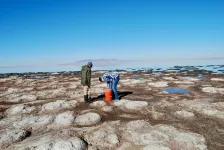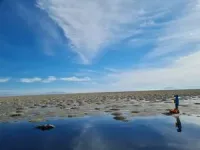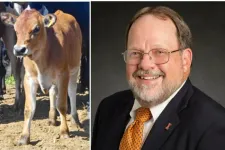(Press-News.org) Scientists have long suspected nematodes, commonly known as roundworms, inhabit Utah’s Great Salt Lake sediments, but until recently, no one had actually recovered any there.
It took a University of Utah postdoc with a hammer and loads of field experience to solve the puzzle. Along with biology professor Michael Werner, postdoctoral researcher Julie Jung announced in a study published March 13 that they discovered thousands of tiny worms in the lake’s microbialites, those reef-like structures that cover about a fifth of the lakebed.
Their initial attempts failed to find nematodes in lakebed sediments, prompting Jung to take a hammer to samples of microbialites where she struck biological pay dirt. Breaking up the carbonate structures yielded nematode specimens representing several species, resulting in a significant discovery.
Previously, only two multicellular animals have been known to inhabit the lake’s highly saline waters—brine shrimp and brine flies. Now there is a third, opening several new lines of inquiry into Great Salt Lake’s largely hidden web of life.
With more than 250,000 known species, nematodes comprise the world’s most abundant animal phylum in both aquatic and terrestrial biospheres. They live deep in the oceans, deep underground, and in frigid, arid conditions. The nematode species Caenorhabditis elegans is used in science as a model organism whose genome has been thoroughly mapped.
The new Great Salt Lake findings represent the most saline environment where nematodes have ever been recovered, according to Werner, an assistant professor in the university’s School of Biological Sciences.
“Just what is the limit of animal life? What environments can animals actually survive? That captures some imagination about looking at other planets where we might find complex multicellular life,” said Werner, the senior author of a study published in the Proceedings of the Royal Society B. “If there was life also on Mars, it might have looked a little bit like the [lake’s ultrasalty] North Arm right now.”
But there’s even more to the story. In a “crazy” side experiment, Werner’s team fed bacteria from the lake to C. elegans to see what would happen if they exposed these worms to the lake’s water, which is 50 times more saline than this species’ usual habitat.
After 24 hours, these worms were still alive, while those nourished on the model species’ usual diet were dead within five minutes.
“We didn’t expect it to work, but it did!” Werner exclaimed. This suggests that bacteria can help nematodes adapt to highly saline conditions, but more research is needed to identify the mechanisms at play.
The new study builds on the prior research of Bonnie Baxter, a Westminster University biology professor who has studied Great Salt Lake halophilic microorganisms, and Brigham Young University biologist Byron Adams, a leading expert in nematodes, with whom Werner consulted when he set up his search.
“Even today we're discovering these amazing things about this lake that's been sitting on our doorstep for 170 years,” Adams marveled. “It’s an amazing system that Michael has worked to better understand.”
Adams has discovered nematodes in some of the most extreme environments on Earth, such as Antarctica, yet was surprised Werner’s team found them in the Great Salt Lake
“I’d looked there myself for them, but I didn't look in the same places where Michael went,” Adams said. “I had initially started to work up in the North Arm, where conditions are obviously a lot more extreme, and I didn't find things there. I just didn't put in the time. I didn't put in the effort to sample more rigorously or more thoroughly.”
Nematodes are Earth’s most abundant animal. Werner said 80% of all animal life on the terrestrial soil and 90% on the ocean floor are nematodes. Because these worms inhabit completely different environments across the globe, many have suspected they also inhabit the Great Salt Lake.
But as Adams learned, finding them proved the tricky part.
Werner and his colleagues began their worm-hunting surveys in the spring of 2021 when they sampled three sites in the South Arm where salt concentrations are 10 to 20%, or three to six times saltier than the ocean.
These sites were at the southern end of Fremont Island, the northern end of Antelope Island and a point midway between. Led by Jung, the team initially used kayaks to access these sites in the spring of 2021, but water levels dropped so much in a year that they had to return by mountain bike and foot to gather the samples during the summer and fall.
“At first it was just scooping up segment samples. But then once we noticed microbialites, we shoveled little chunks of them, tried to preserve the layers, and brought them back to the lab,” said Jung, whom the College of Science has named one of its outstanding postdocs.
Initially, the team could not detect any worms using standard techniques, but after the researchers adopted a method called sucrose-density centrifugation they consistently recovered live nematodes from every site.
Werner’s team believes the nematodes feed on the bacteria that form mats on the microbialites. The mats may also protect from the sun’s ultraviolet light.
Nearly all the nematodes recovered in the South Arm came from a single family, Monhysteridae, an ancient branch of the nematode phylum known for its association with deep-sea hydrothermal vents and ability to adapt to extreme environments. Characterizing and naming the potentially new species of nematodes will be the task of additional studies.
Among the study’s key discoveries was a powerful association between nematode abundance and microbialites, further demonstrating the ecological importance of these structures, each about a meter across and formed by microbes.
Understanding the formation and biota of these structures could provide important clues to the origin and ecology of early life on our planet. However, much of the lake's microbialite networks are no longer submerged, leaving them dry and exposed, thanks to the lake’s low water levels.
As a result, exposed microbialite habitat and record-high salinity levels threaten both benthic zone inhabitants, such as brine flies and algae, and the upper trophic levels (i.e. waterfowl) that depend on them. Thus, there is a pressing need to understand this lynchpin community and the limits of their habitability.
The National Science Foundation funded the study, titled “Halophilic nematodes live in America's Dead Sea,” with additional funding from the University of Utah. Other authors include U graduate student Shelley Reich, and Tobias Loschko of the Max Planck Institute for Biology.
END
With discovery of roundworms, Great Salt Lake’s imperiled ecosystem gets more interesting
Brine shrimp and brine flies aren't the only animals inhabiting the lake. Utah biologists find tiny nematodes in its reef-like microbialites
2024-03-13
ELSE PRESS RELEASES FROM THIS DATE:
Most consumers continue to expect rising food prices
2024-03-13
Most U.S. consumers surveyed in February 2024 predicted that they would see an increase in food prices over the next 12 months. Sixty-four percent of respondents predict food prices to rise in the next year, and the average predicted increase is 3.7%, according to the February Consumer Food Insights Report.
The survey-based report out of Purdue University’s Center for Food Demand Analysis and Sustainability assesses food spending, consumer satisfaction and values, support of agricultural and food policies and trust in information sources. Purdue experts conducted and evaluated the survey, which ...
Innovative approaches for addressing difficult topics in K-12 schools
2024-03-13
UNIVERSITY PARK, Pa. — Three peer-reviewed journals have recently published research papers by Penn State’s Hammel Family Human Rights Initiative. The papers illustrate how the initiative’s programs help K-12 educators address difficult issues such as racism.
The three journals that published the initiative papers are School-University Partnerships, Journal of Practitioner Research and Journal of Teacher Education. JTE, as it’s known, is widely considered the top-ranked research journal in the field of teacher education. Some of the scholars who independently ...
Methane emissions from U.S. oil and gas operations cost the nation $10 billion per year
2024-03-13
Oil and gas operations across the United States are emitting more than 6 million tons per year of methane, the main component of natural gas and the most abundant greenhouse gas after carbon dioxide, according to Stanford-led research published March 13 in Nature.
These emissions, which result from both intentional vents and unintentional leaks, amount to $1 billion in lost commercial value for energy producers. The annual cost rises to $10 billion when researchers account for harm to the economy and human well-being caused by adding this amount of heat-trapping methane ...
Explaining a supernova's 'string of pearls'
2024-03-13
Images
Physicists often turn to the Rayleigh-Taylor instability to explain why fluid structures form in plasmas, but that may not be the full story when it comes to the ring of hydrogen clumps around supernova 1987A, research from the University of Michigan suggests.
In a study published in Physical Review Letters, the team argues that the Crow instability does a better job of explaining the "string of pearls" encircling the remnant of the star, shedding light on a longstanding astrophysical mystery.
"The fascinating ...
Marine heat waves disrupt the ocean food web in the northeast Pacific Ocean
2024-03-13
NEWPORT, Ore. – Marine heat waves in the northeast Pacific Ocean create ongoing and complex disruptions of the ocean food web that may benefit some species but threaten the future of many others, a new study has shown.
The study, just published in the journal Nature Communications, is the first of its kind to examine the impacts of marine heat waves on the entire ocean ecosystem in the northern California Current, the span of waters along the West Coast from Washington to Northern California.
The researchers found that the biggest beneficiary of marine heat waves is gelatinous zooplankton – predominantly ...
The 11th World Congress on Microbiota Medicine critically evaluates probiotic supplementation strategies
2024-03-13
The International Society of Microbiota (ISM) announces its 11th World Congress, "Targeting Microbiota 2024", scheduled for October 14-15 at the Corinthia Palace in Malta. This event is set to highlight the latest research and developments in microbiotal medicine, emphasizing its impact on human health and its potential in shaping future medical treatment approaches.
Detailed Workshop: Probiotic Prescribing Practices dedicated to Medical Professionals
The congress will feature a critical workshop on October 15, titled “Probiotic Prescribing Practices: Empowering Medical Doctors for Improved Patient Health.” ...
Engineering Biology Research Consortium releases roadmap to mitigate, present and adapt to climate change
2024-03-13
Engineering Biology for Climate & Sustainability is the fifth technical roadmap developed by the Engineering Biology Research Consortium (EBRC) and represents the first dedicated to innovations and opportunities towards overcoming a significant global challenge. The roadmap targets and challenges are aligned and were drawn from existing climate and sustainability literature, particularly those focused on long-term impacts and opportunities, including reports from the United Nations’ Intergovernmental Panel on Climate Change and the U.S. Environmental Protection Agency.
The roadmap consists of six themes ...
Strengthening the partnership between humans and AI: the case of translators
2024-03-13
ChatGPT and its ability to hold conversations and produce written content have been the focus of a lot of attention in the last year in the field of technology and artificial intelligence. However, AI has been around for some time, helping us in all sorts of everyday tasks, from navigation systems to social network algorithms, not to mention machine translation. Ever since neural machine translation (NMT) systems began to be used on a widespread basis a few years ago, AI has seen exponential growth in its uptake in the translation industry. This has led to new challenges in the relationship between human and machine translators.
Today, the post-editing ...
Milk to the rescue for diabetics? Cow produces human insulin in milk
2024-03-13
An unassuming brown bovine from the south of Brazil has made history as the first transgenic cow capable of producing human insulin in her milk. The advancement, led by researchers from the University of Illinois Urbana-Champaign and the Universidade de São Paulo, could herald a new era in insulin production, one day eliminating drug scarcity and high costs for people living with diabetes.
“Mother Nature designed the mammary gland as a factory to make protein really, really efficiently. We can take advantage ...
Molecular simulations of ammonia mixtures support search for renewable fuels
2024-03-13
Ammonia (NH3) is an important molecule with many applications. The end product of the famed Haber–Bosch process, it is commonly synthesized to capture nitrogen for fertilizers, and is used for refrigeration, in cleaning products, and in the production of pharmaceuticals. Recently, this modest molecule has also attracted interest as a potential resource for addressing one of today’s most pressing challenges — the need for reliable and abundant renewable fuels.
Ammonia is stable and safe ...
LAST 30 PRESS RELEASES:
New study highlights link between eviction rates and gun violence
Heatwaves heat up soil but not toxin levels in rice, study finds
Digital modeling reveals where construction carbon emissions really come from
Turning farm waste into water filters
New study shows how the spleen helps the immune system accept a transplant
New Mayo Clinic study advances personalized prostate cancer education with an EHR-integrated AI agent
Researchers identify novel therapeutic target to improve recovery after nerve injury
Microbes in breast milk help populate infant gut microbiomes
Reprogramming immunity to rewrite the story of Type 1 diabetes
New tool narrows the search for ideal material structures
Artificial saliva containing sugarcane protein helps protect the teeth of patients with head and neck cancer
Understanding the role of linear ubiquitination in T-tubule biogenesis
Researchers identify urban atmosphere as primary reservoir of microplastics
World’s oldest arrow poison – 60,000-year-old traces reveal early advanced hunting techniques
Bristol scientists discover early sponges were soft
New study uncovers how rice viruses manipulate plant defenses to protect insect vectors
NSF–DOE Vera C. Rubin Observatory spots record-breaking asteroid in pre-survey observations
Ribosomal engineering creates “super-probiotic” bacteria
This self-powered eye tracker harnesses energy from blinking and is as comfortable as everyday glasses
Adverse prenatal exposures linked to higher rates of mental health issues, brain changes in adolescents
Restoring mitochondria shows promise for treating chronic nerve pain
Nature study identifies a molecular switch that controls transitions between single-celled and multicellular forms
USU chemists' CRISPR discovery could lead to single diagnostic test for COVID, flu, RSV
Early hominins from Morocco reveal an African lineage near the root of Homo sapiens
Small chimps, big risks: What chimps show us about our own behavior
We finally know how the most common types of planets are created
Thirty-year risk of cardiovascular disease among healthy women according to clinical thresholds of lipoprotein(a)
Yoga for opioid withdrawal and autonomic regulation
Gene therapy ‘switch’ may offer non-addictive pain relief
Study shows your genes determine how fast your DNA mutates with age
[Press-News.org] With discovery of roundworms, Great Salt Lake’s imperiled ecosystem gets more interestingBrine shrimp and brine flies aren't the only animals inhabiting the lake. Utah biologists find tiny nematodes in its reef-like microbialites






